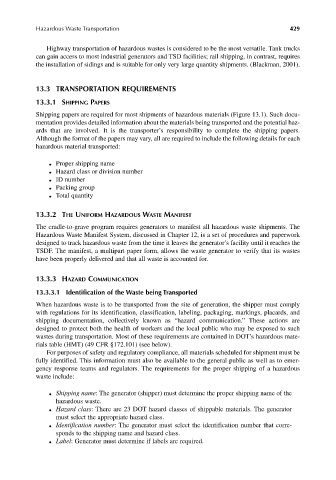Page 458 - Materials Chemistry, Second Edition
P. 458
CAT3525_C13.qxd 1/27/2005 12:30 PM Page 429
Hazardous Waste Transportation 429
Highway transportation of hazardous wastes is considered to be the most versatile. Tank trucks
can gain access to most industrial generators and TSD facilities; rail shipping, in contrast, requires
the installation of sidings and is suitable for only very large quantity shipments. (Blackman, 2001).
13.3 TRANSPORTATION REQUIREMENTS
13.3.1 SHIPPING PAPERS
Shipping papers are required for most shipments of hazardous materials (Figure 13.1). Such docu-
mentation provides detailed information about the materials being transported and the potential haz-
ards that are involved. It is the transporter’s responsibility to complete the shipping papers.
Although the format of the papers may vary, all are required to include the following details for each
hazardous material transported:
● Proper shipping name
● Hazard class or division number
● ID number
● Packing group
● Total quantity
13.3.2 THE UNIFORM HAZARDOUS WASTE MANIFEST
The cradle-to-grave program requires generators to manifest all hazardous waste shipments. The
Hazardous Waste Manifest System, discussed in Chapter 12, is a set of procedures and paperwork
designed to track hazardous waste from the time it leaves the generator’s facility until it reaches the
TSDF. The manifest, a multipart paper form, allows the waste generator to verify that its wastes
have been properly delivered and that all waste is accounted for.
13.3.3 HAZARD COMMUNICATION
13.3.3.1 Identification of the Waste being Transported
When hazardous waste is to be transported from the site of generation, the shipper must comply
with regulations for its identification, classification, labeling, packaging, markings, placards, and
shipping documentation, collectively known as “hazard communication.” These actions are
designed to protect both the health of workers and the local public who may be exposed to such
wastes during transportation. Most of these requirements are contained in DOT’s hazardous mate-
rials table (HMT) (49 CFR §172.101) (see below).
For purposes of safety and regulatory compliance, all materials scheduled for shipment must be
fully identified. This information must also be available to the general public as well as to emer-
gency response teams and regulators. The requirements for the proper shipping of a hazardous
waste include:
● Shipping name: The generator (shipper) must determine the proper shipping name of the
hazardous waste.
● Hazard class: There are 23 DOT hazard classes of shippable materials. The generator
must select the appropriate hazard class.
● Identification number: The generator must select the identification number that corre-
sponds to the shipping name and hazard class.
● Label: Generator must determine if labels are required.

